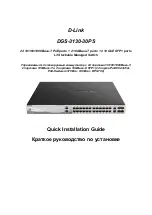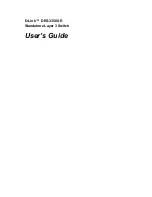
DGS-1510/ME Series Metro Ethernet Switch Hardware Installation Guide
2
•
Observe and follow service markings.
•
Do not service any product except as explained in the system documentation.
•
Opening or removing covers that are marked with the triangular symbol with a lightning bolt may expose the
user to electrical shock.
o
Only a trained service technician should service components inside these compartments.
•
If any of the following conditions occur, unplug the product from the electrical outlet and replace the part or
contact your trained service provider:
o
Damage to the power cable, extension cable, or plug.
o
An object has fallen into the product.
o
The product has been exposed to water.
o
The product has been dropped or damaged.
o
The product does not operate correctly when the operating instructions are correctly followed.
•
Keep your system away from radiators and heat sources. Also, do not block cooling vents.
•
Do not push any objects into the openings of the system. Doing so can cause fire or electric shock by shorting
out interior components.
•
Use the product only with approved equipment.
•
Allow the product to cool before removing covers or touching internal components.
•
Operate the product only from the type of external power source indicated on the electrical ratings label. If
unsure of the type of power source required, consult your service provider or local power company.
•
To help avoid damaging the system, be sure the voltage selection switch (if provided) on the power supply is
set to match the power available at the Switch’s location:
o
115 volts (V)/60 hertz (Hz) in most of North and South America and some Far Eastern countries such
as South Korea and Taiwan
o
100 V/50 Hz in eastern Japan and 100 V/60 Hz in western Japan
o
230 V/50 Hz in most of Europe, the Middle East, and the Far East
•
Also, be sure that attached devices are electrically rated to operate with the power available in your location.
•
Use only approved power cable(s). If you have not been provided with a power cable for your system or for
any AC-powered option intended for your system, purchase a power cable that is approved for use in your
country. The power cable must be rated for the product and for the voltage and current marked on the
product's electrical ratings label. The voltage and current rating of the cable should be greater than the ratings
marked on the product.
•
To help prevent electric shock, plug the system and peripheral power cables into properly grounded electrical
outlets. These cables are equipped with three-prong plugs to help ensure proper grounding. Do not use
adapter plugs or remove the grounding prong from a cable. If using an extension cable is necessary, use a 3-
wire cable with properly grounded plugs.
•
Observe extension cable and power strip ratings. Make sure that the total ampere rating of all products
plugged into the extension cable or power strip does not exceed 80 percent of the ampere ratings limit for the
extension cable or power strip.
•
To help protect the system from sudden, transient increases and decreases in electrical power, use a surge
suppressor, line conditioner, or uninterruptible power supply (UPS).
•
Position system cables and power cables carefully; route cables so that they cannot be stepped on or tripped
over. Be sure that nothing rests on any cables.
•
Do not modify power cables or plugs. Consult a licensed electrician or your power company for site
modifications. Always follow your local/national wiring rules.
•
When connecting or disconnecting power to hot-pluggable power supplies, if offered with your system,
observe the following guidelines:
o
Install the power supply before connecting the power cable to the power supply.
o
Unplug the power cable before removing the power supply.
o
If the system has multiple sources of power, disconnect power from the system by unplugging all power
cables from the power supplies.
Содержание DGS-1510-10L/ME
Страница 1: ......
Страница 3: ... FCC 21 CFR Chapter 1 Subchapter J in accordance with FDA CDRH requirements ...
Страница 67: ......








































